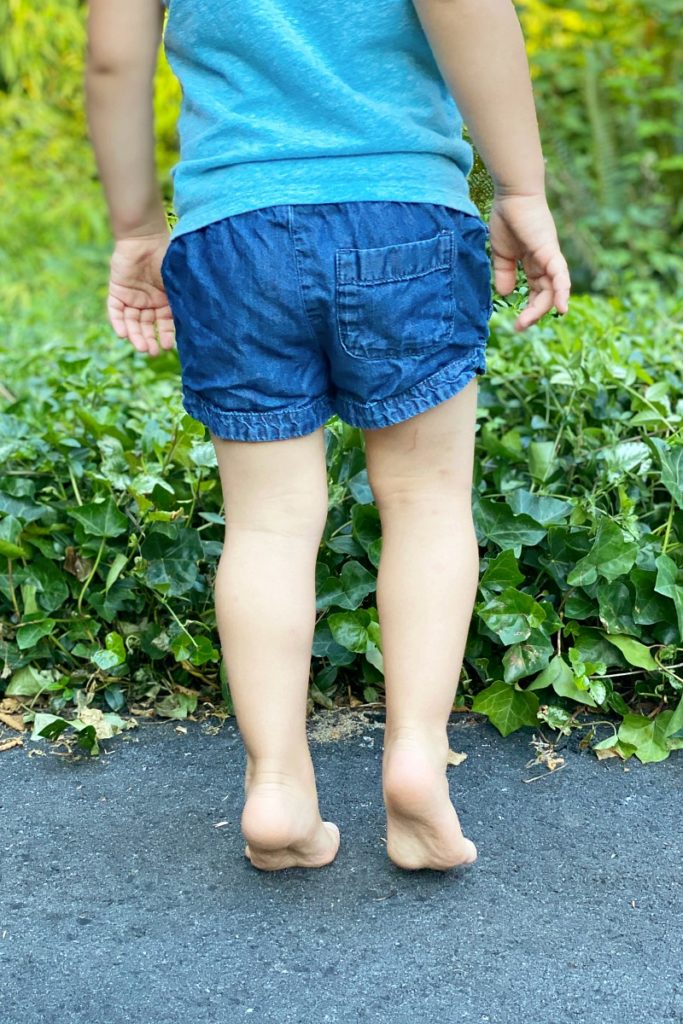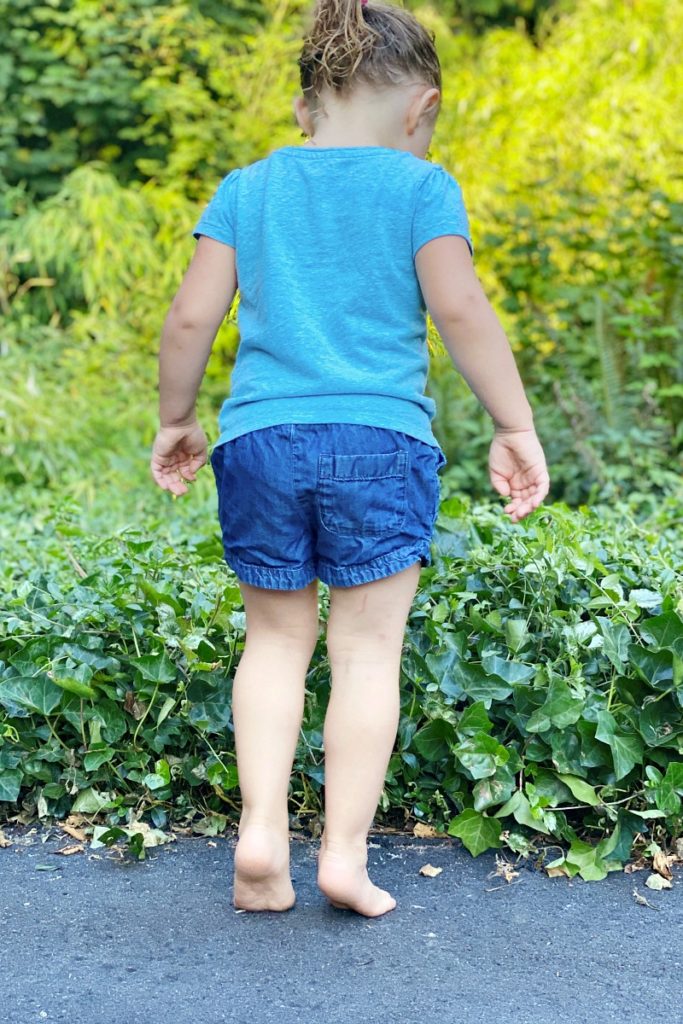Learn more about the causes and concerns of idiopathic toe walking and what activities you can do to help your child develop a more typical walking pattern.

What is idiopathic toe walking?
Toe walking is when a child walks up on the balls of their feet without their heels touching the ground. While there can be many medical conditions that can cause toe walking, idiopathic toe walking refers to those toe walkers that have an unknown cause. It is also sometimes called behavioural or habitual toe walking.
Is toe walking typical when a child first starts to walk?
Most children begin to walk with their feet flat on the ground. There are some children, however, that will start to walk more on their tip toes instead. This isn’t a huge concern initially as this pattern will usually resolve within the first 6 months of learning to walk. Continued toe walking beyond 3 years of age can become more of an issue.
Why is persistent toe walking a concern?
Toe walkers tend to lock their ankles, knees and hips in a straight position to reduce the amount of work on their muscles. This leads to more weakness in the tummy (core) and leg muscles as well as tightness in the calf muscles. This can progress over time and make toe walking more difficult to correct as the child gets older.
Functionally, they may have difficulty going up (and especially) down stairs, difficulty with balance, and more frequent tripping and falling. If kids continue to toe walk it can lead to pain in the back, legs or feet or even develop into more permanent foot deformities.
Why does my child toe walk on their toes?
Assuming that medical reasons have been ruled out, there are a few reasons that children may still prefer to walk on their toes.
Sensory Avoidance
Some kids don’t like the feeling of their feet coming into contact with different textures and surfaces so they will go up on their toes to try to avoid it. These kids might also have other tactile sensitivities like only wanting to wear certain clothing materials, avoiding clothing tags, or having an aversion to socks or shoes.
Sensory Seeking
On the other end of the sensory spectrum, some kids toe walk to increase their sensory input. Being up on the toes provides more information to the proprioceptive system which helps children have a better idea of where they are in space. Children seeking proprioceptive input toe walk because this prolongs stimulation of the joint receptors and muscles in the feet and lower legs. In turn, this provides a calming and organizing effect for the child.
TIGHT CALF MUSCLES
Unless there are other issues causing increased muscle tone, a child doesn’t usually start walking on their toes due to tight calf muscles. If they continue to prolong toe walk, however, these calf muscles can become increasing tight making it more difficult for your child to go back down onto a flat foot.
Vestibular System Dysfunction
Our vestibular system in the inner ear is responsible for our sense of movement and balance. Children with vestibular issues have a different awareness of their body position and go up on their toes to feel more stabilized..
HABIT
Some kids just like the feeling of walking on their toes and it becomes more habitual than anything. If this is the case, the earlier you can reverse it, the better the chance you have of correcting it before any muscle changes occur.
Common Signs/Symptoms
While it’s generally pretty obvious when a child is up and walking on their toes, here are some common presentations associated specifically with idiopathic toe walking…
- Walks up on toes on both legs for the majority of the time
- Will often stand on flat feet but goes more up onto toes with walking and running activities
- Are constantly balancing up on their toes
- Generally started walking on time and can keep up with peers
- Walk with straighter knees (“locks” ankles and knees)
- May have a family history of toe walking

Active Stretches and Play Positions
Children love to move, so encouraging calf stretching and strengthening through regular play activities is often the easiest (and most fun!) way to help with decreasing the frequency of toe walking. The more you can incorporate these activities into your regular daily activities, the better. Here are some activities to try…
Standing/Walking Activities
- walk uphill or on other inclines. Go slowly and encourage your child to push heel more down to the ground.
- walk backwards. This shifts the weight to the heels and makes it more difficult to stay up on toes.
- walk up a slide. Work to keep heel closer to the ground.
- practice walking with a heel to toe pattern. If this is too hard to do on flat ground, you could start practicing this on a slight decline or ramp (walking down).
- marching on the spot, stomping feet down flat
- marching up stairs landing on flat feet
- walking on heels lifting toes up {penguin walk}. If this is difficult to start with, you an give your child a hand hold to assist with balance.
- squatting activities down to the ground. Encourage play in a squatting position, or set up toys to encourage squatting and standing back up. For example, you could place puzzle pieces on the floor and the puzzle itself up on a raised surface. Prolonged squatting shifts the weight to the heel of the foot and helps strength the muscles in the font of the ankle.
- jumping activities landing on flat feet or jumping down from a small height and landing on flat feet with knees bent. Emphasize the bending of the knees prior to take-off.
- do an activity with your child on an incline wedge for a sustained stretch or position the feet on an incline wedge when sitting
- animal walks such as bear walking, crab walking, or duck walking (in a crouched position)
- have some fun and practice walking in flippers!
Sitting Activities
- Sit in a lower chair or stool with feet flat on the ground. Slide the feet slowly backwards as far as you can keeping the heel on the ground. Maintain this position while doing an activity.
- Sit in a chair with heels on the ground and place a rolled up towel or other small, solid item under the ball of the foot to lift the foot up a bit (continue to keep heels on the ground). Maintain this position while doing an activity.
- Sit to stand activities. Sit on the edge of a chair with feet and heels flat on the floor with feet back towards the body as far as possible. Trying to keep feet flat, lean forwards and stand up.
Strengthening Activities
- Balance on one leg. If some balance assistance is initially required, have child place one finger on top of your hand for support to place one finger on the wall or table for support.
- Do an activity with child standing on a disc cushion or balance board to strengthening ankle and core muscles (at home you could do this on a pillow or two or yoga mat). Progress to doing this on one leg.
- In sitting, keep heels on the floor and lift up the rest of the foot. This will be easier if the feet are further away from the body. Slide them in more towards the body as able.
- Squish feet in the sand trying to curl up your foot.
- Pick up objects such as large pom poms, small bean bags or other similar items with feet and place in a bucket. Start in sitting and progress to standing.
- In standing, place a bean bag on top of foot. Keeping the bean bag from falling off, lift up the foot and dump bean bag in a small bucket. The higher the bucket, the harder the activity,
- Core exercises such as bridging, animal walks, superman, or 4 point kneeling lifting the opposite hand and leg to strengthen the core muscles and buttock muscles.
Other interventions for Toe Walking
If your child starts to develop more significant tightness in the calf muscles, or the toe walking starts to interfere with your child’s typical development and participation, further medical interventions are available. This could include:
- ankle foot orthosis (AFOs) to help maintain a constant stretch on the calf muscles and inhibit the motion of going up onto toes
- Botox injections to help relax the calf muscles
- Serial casting of the foot and ankle to gradually stretch out the calf muscles.
- Tendon lengthening surgery.
As always, these activities are meant for guidance and ideas only. Please refer to your paediatrician or therapist if you have any concerns regarding your child’s development. There can be many reasons for toe walking, so you want to make sure that you’re working on addressing the specific concerns for your own child.

Leave a Reply